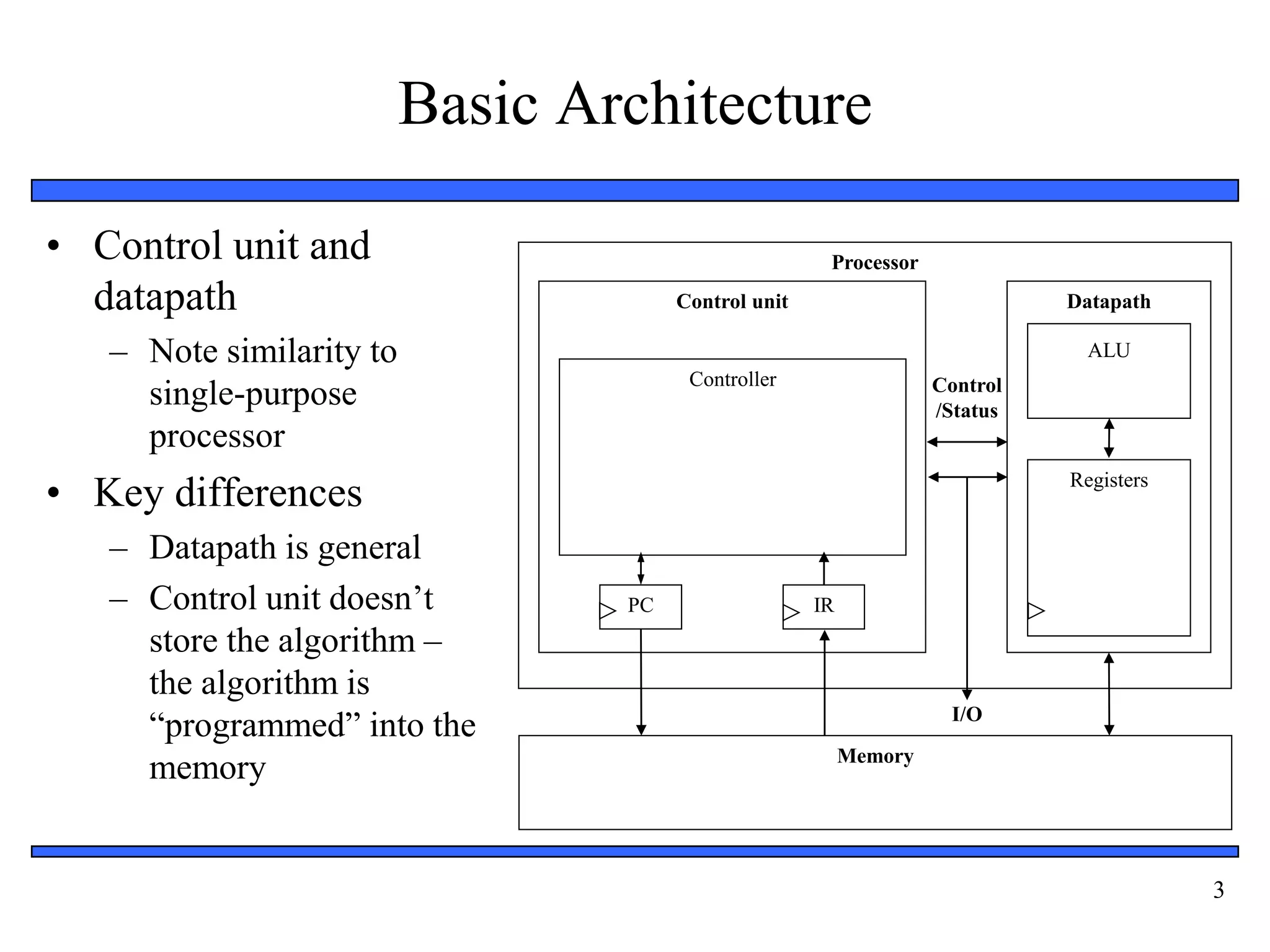This document discusses general-purpose processors. It begins by introducing general-purpose processors and their basic architecture, which consists of a control unit and datapath that is designed to perform a variety of computation tasks. It then describes the operations of loading, storing, and arithmetic/logical operations that can be performed by the datapath. Subsequent sections provide more details on the control unit and how it sequences operations, instruction cycles, architectural considerations like bit-width and clock frequency, and techniques for improving performance like pipelining and superscalar execution. The document concludes with sections on assembly-level instructions and programmer considerations.




![5
Control Unit
• Control unit: configures the datapath
operations
– Sequence of desired operations
(“instructions”) stored in memory –
“program”
• Instruction cycle – broken into
several sub-operations, each one
clock cycle, e.g.:
– Fetch: Get next instruction into IR
– Decode: Determine what the
instruction means
– Fetch operands: Move data from
memory to datapath register
– Execute: Move data through the
ALU
– Store results: Write data from
register to memory
Processor
Control unit Datapath
ALU
Registers
IR
PC
Controller
Memory
I/O
Control
/Status
10
...
...
load R0, M[500]
500
501
100
inc R1, R0
101
store M[501], R1
102
R0 R1](https://image.slidesharecdn.com/unit3-generalpurposeprocessors-230124170009-ad904f8d/75/UNIT-3-General-Purpose-Processors-5-2048.jpg)
![6
Control Unit Sub-Operations
• Fetch
– Get next instruction
into IR
– PC: program
counter, always
points to next
instruction
– IR: holds the
fetched instruction
Processor
Control unit Datapath
ALU
Registers
IR
PC
Controller
Memory
I/O
Control
/Status
10
...
...
load R0, M[500]
500
501
100
inc R1, R0
101
store M[501], R1
102
R0 R1
100
load R0, M[500]](https://image.slidesharecdn.com/unit3-generalpurposeprocessors-230124170009-ad904f8d/75/UNIT-3-General-Purpose-Processors-6-2048.jpg)
![7
Control Unit Sub-Operations
• Decode
– Determine what the
instruction means
Processor
Control unit Datapath
ALU
Registers
IR
PC
Controller
Memory
I/O
Control
/Status
10
...
...
load R0, M[500]
500
501
100
inc R1, R0
101
store M[501], R1
102
R0 R1
100
load R0, M[500]](https://image.slidesharecdn.com/unit3-generalpurposeprocessors-230124170009-ad904f8d/75/UNIT-3-General-Purpose-Processors-7-2048.jpg)
![8
Control Unit Sub-Operations
• Fetch operands
– Move data from
memory to datapath
register
Processor
Control unit Datapath
ALU
Registers
IR
PC
Controller
Memory
I/O
Control
/Status
10
...
...
load R0, M[500]
500
501
100
inc R1, R0
101
store M[501], R1
102
R0 R1
100
load R0, M[500]
10](https://image.slidesharecdn.com/unit3-generalpurposeprocessors-230124170009-ad904f8d/75/UNIT-3-General-Purpose-Processors-8-2048.jpg)
![9
Control Unit Sub-Operations
• Execute
– Move data through
the ALU
– This particular
instruction does
nothing during this
sub-operation
Processor
Control unit Datapath
ALU
Registers
IR
PC
Controller
Memory
I/O
Control
/Status
10
...
...
load R0, M[500]
500
501
100
inc R1, R0
101
store M[501], R1
102
R0 R1
100
load R0, M[500]
10](https://image.slidesharecdn.com/unit3-generalpurposeprocessors-230124170009-ad904f8d/75/UNIT-3-General-Purpose-Processors-9-2048.jpg)
![10
Control Unit Sub-Operations
• Store results
– Write data from
register to memory
– This particular
instruction does
nothing during this
sub-operation
Processor
Control unit Datapath
ALU
Registers
IR
PC
Controller
Memory
I/O
Control
/Status
10
...
...
load R0, M[500]
500
501
100
inc R1, R0
101
store M[501], R1
102
R0 R1
100
load R0, M[500]
10](https://image.slidesharecdn.com/unit3-generalpurposeprocessors-230124170009-ad904f8d/75/UNIT-3-General-Purpose-Processors-10-2048.jpg)
![11
Instruction Cycles
Processor
Control unit Datapath
ALU
Registers
IR
PC
Controller
Memory
I/O
Control
/Status
10
...
...
load R0, M[500]
500
501
100
inc R1, R0
101
store M[501], R1
102
R0 R1
PC=100
10
Fetch
ops
Exec. Store
results
clk
Fetch
load R0, M[500]
Decode
100](https://image.slidesharecdn.com/unit3-generalpurposeprocessors-230124170009-ad904f8d/75/UNIT-3-General-Purpose-Processors-11-2048.jpg)
![12
Instruction Cycles
Processor
Control unit Datapath
ALU
Registers
IR
PC
Controller
Memory
I/O
Control
/Status
10
...
...
load R0, M[500]
500
501
100
inc R1, R0
101
store M[501], R1
102
R0 R1
10
PC=100
Fetch Decode Fetch
ops
Exec. Store
results
clk
PC=101
inc R1, R0
Fetch Fetch
ops
+1
11
Exec. Store
results
clk
101
Decode](https://image.slidesharecdn.com/unit3-generalpurposeprocessors-230124170009-ad904f8d/75/UNIT-3-General-Purpose-Processors-12-2048.jpg)
![13
Instruction Cycles
Processor
Control unit Datapath
ALU
Registers
IR
PC
Controller
Memory
I/O
Control
/Status
10
...
...
load R0, M[500]
500
501
100
inc R1, R0
101
store M[501], R1
102
R0 R1
11
10
PC=100
Fetch Decode Fetch
ops
Exec. Store
results
clk
PC=101
Fetch Decode Fetch
ops
Exec. Store
results
clk
PC=102
store M[501], R1
Fetch Fetch
ops
Exec.
11
Store
results
clk
Decode
102](https://image.slidesharecdn.com/unit3-generalpurposeprocessors-230124170009-ad904f8d/75/UNIT-3-General-Purpose-Processors-13-2048.jpg)










![24
Sample Programs
int total = 0;
for (int i=10; i!=0; i--)
total += i;
// next instructions...
C program
MOV R0, #0; // total = 0
MOV R1, #10; // i = 10
JZ R1, Next; // Done if i=0
ADD R0, R1; // total += i
MOV R2, #1; // constant 1
JZ R3, Loop; // Jump always
Loop:
Next: // next instructions...
SUB R1, R2; // i--
Equivalent assembly program
MOV R3, #0; // constant 0
0
1
2
3
5
6
7
• Try some others
– Handshake: Wait until the value of M[254] is not 0, set M[255] to 1, wait
until M[254] is 0, set M[255] to 0 (assume those locations are ports).
– (Harder) Count the occurrences of zero in an array stored in memory
locations 100 through 199.](https://image.slidesharecdn.com/unit3-generalpurposeprocessors-230124170009-ad904f8d/75/UNIT-3-General-Purpose-Processors-24-2048.jpg)







![33
Instruction Set Simulator For A Simple
Processor
#include <stdio.h>
typedef struct {
unsigned char first_byte, second_byte;
} instruction;
instruction program[1024]; //instruction memory
unsigned char memory[256]; //data memory
void run_program(int num_bytes) {
int pc = -1;
unsigned char reg[16], fb, sb;
while( ++pc < (num_bytes / 2) ) {
fb = program[pc].first_byte;
sb = program[pc].second_byte;
switch( fb >> 4 ) {
case 0: reg[fb & 0x0f] = memory[sb]; break;
case 1: memory[sb] = reg[fb & 0x0f]; break;
case 2: memory[reg[fb & 0x0f]] =
reg[sb >> 4]; break;
case 3: reg[fb & 0x0f] = sb; break;
case 4: reg[fb & 0x0f] += reg[sb >> 4]; break;
case 5: reg[fb & 0x0f] -= reg[sb >> 4]; break;
case 6: pc += sb; break;
default: return –1;
}
}
return 0;
}
int main(int argc, char *argv[]) {
FILE* ifs;
If( argc != 2 ||
(ifs = fopen(argv[1], “rb”) == NULL ) {
return –1;
}
if (run_program(fread(program,
sizeof(program) == 0) {
print_memory_contents();
return(0);
}
else return(-1);
}](https://image.slidesharecdn.com/unit3-generalpurposeprocessors-230124170009-ad904f8d/75/UNIT-3-General-Purpose-Processors-32-2048.jpg)



